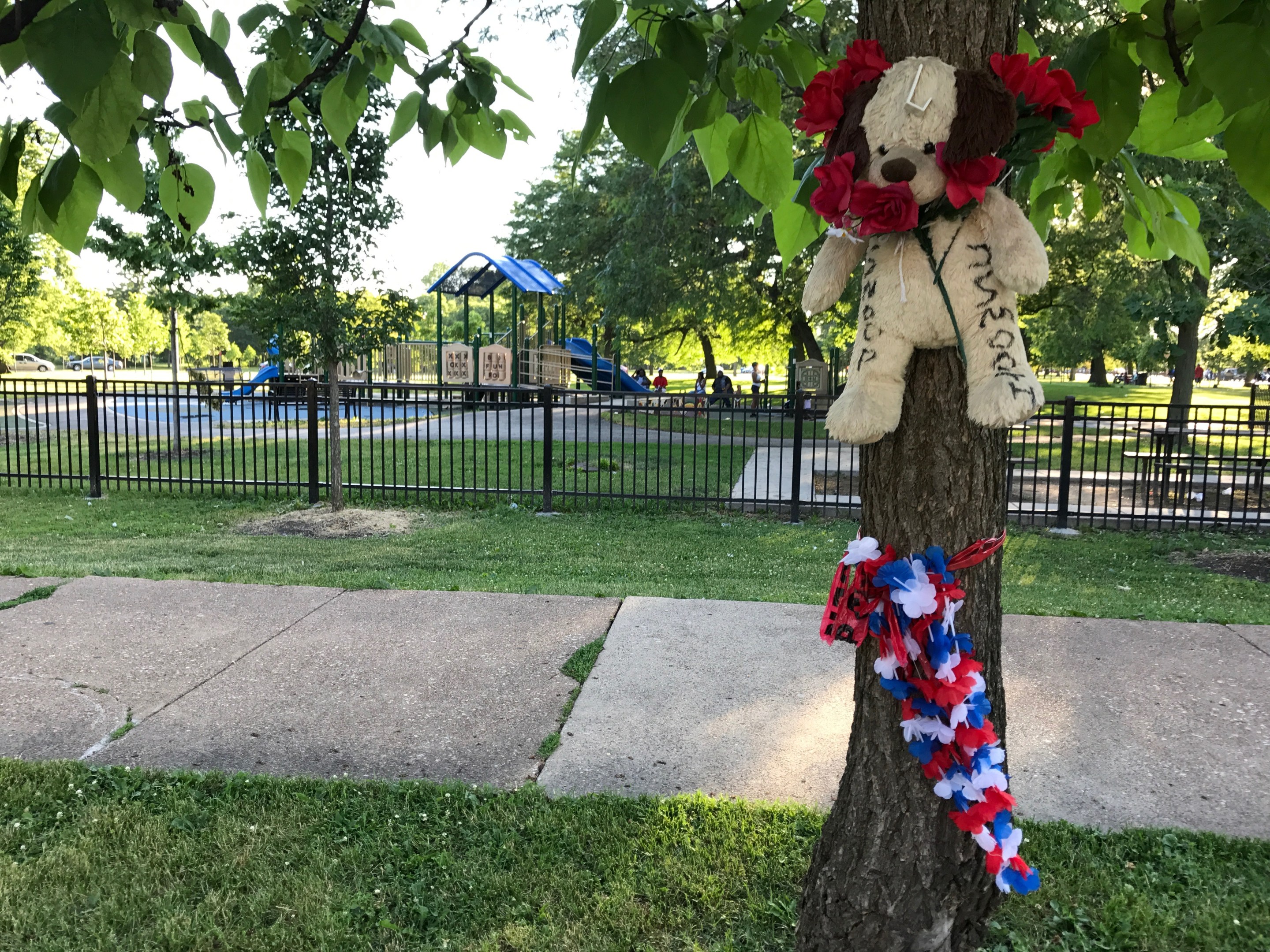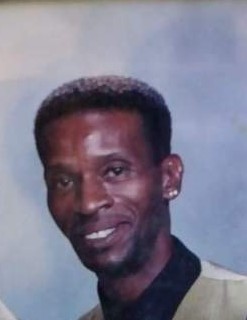Did the Police Close the Louis Smith Bike Fatality Case Solely Based on Driver Testimony?
4:36 PM CDT on June 22, 2017

The memorial to Louis Ray Smith at the crash site. Photo: John Greenfield
[The Chicago Reader publishes a weekly transportation column written by Streetsblog Chicago editor John Greenfield. We syndicate a portion of the column on Streetsblog after it comes out online.]
Judging from the memorial to fallen cyclist Louis Ray Smith at the East Garfield Park crash site, the 56-year-old was a well-loved man. The shrine is located about 200 feet south of the roaring Lake Street elevated train, on the west side of Homan Avenue, next to a popular playground in Garfield Park, within sight of the gleaming gold dome of the park’s fieldhouse. Friends and relatives planted red, white, and blue artificial flowers in the grass and burned memorial candles on the curb. A colorful lei and a stuffed beagle with “Snoop” and “Smooth,” the nicknames of friends, written on its fur in marker are tied to a tree. On blue paper taped to a lamppost, mourners left messages like “Rest up uncle—love U 2 pieces,” “Nothing compares to yoo—R.I.P. Ray,” and “I’m gonna miss U dude, but never will U be 4 gotten.”
On Monday, June 5, at about 8:35 PM, Smith was biking north on Homan when he was struck by a southbound driver in a Chrysler 200 sedan, according to the Chicago Police Department. The crash report stated that the cyclist “swerved into the vehicle,” suggesting that he was to blame for his own death, and all of the mainstream local news reports used that phrase.
However, according to CPD, there were no witnesses to the crash, so that preliminary description of events was merely be the driver’s side of the story. Smith, tragically, wasn’t alive to give his account. The phenomenon of police presenting motorists’ accounts of fatal or serious bike crashes as fact can be a roadblock to finding out what really happened to these victims and making sure justice is served.
Smith was born in 1960 to a family with eight other siblings in Batesville, Mississippi, a town of 7,463 on the Tallahatchie River. After laboring more than a decade at a local casket company as a young man, he followed his mother Willeva Smith-Washington to Chicago in search of better opportunities and found work at Jewel and Dominick’s warehouses. He married three times and had nine children of his own.
“He was a good son,” said Smith-Washington, 73, a retired factory worker, reached by phone at her home in west-suburban Maywood. “He liked people and he loved his kids–he was very fond of children. All of his cousins and stuff, they were just crazy about him because he would keep you laughing.” She added that his favorite activity was riding motorcycles, which he’d use to visit family in the suburbs.
Smith-Washington said her son had recently hit a rough patch in life, wasn’t living with his third wife Gerice King, and didn’t have steady employment. “Sometimes you get off on the wrong foot–none of us are perfect,” Smith-Washington said. After the crash, the Cook County medical examiner’s office stated that Louis Ray Smith lived on the 100 block of Sangamon, which Smith-Washington said is the location of a drug and alcohol rehab center. “He stayed there for a while, trying to get himself back on track.” But at the time of the collision he was living with his brothers Bernard and Bennie Washington and nephew Jonathan Spivey, 30, in a house at Homan and Fulton, two blocks north of the crash site.
Smith-Washington added that her son had recently been using a bike to get around since he didn’t own a car. “I think he rode that bike every day, and that’s how he lost his life.”
Lake week I spoke with Spivey, who does construction, by the house on Fulton as his young daughter napped in her stroller. “Uncle Ray was a good man, and he was a very funny guy,” he recalled, adding that Smith made money by fixing cars for friends and neighbors, and sometimes worked with his nephew on painting, drywall, and flooring jobs.
Spivey said that on the night of Smith’s death, his uncle had biked from their house to a gas station at Washington and Homan, a block south of the collision site, to buy a snack. “He loved Nutty Buddies.”
Not long after Smith left on the errand, Spivey drove away from their home with a female friend and they happened upon the crash scene. “He was lying in the middle of the street,” he recalled. “I said, ‘That’s my uncle!’ [The driver] had knocked some teeth out and you really couldn’t recognize his face.” He said the motorist, a young woman with two small boys in her car, was crying and pounding on the side of her vehicle. Smith was transported to Mount Sinai Hospital, where he was pronounced dead at 9:12 PM.
Smith’s funeral took place on June 17 at New Mount Moriah Missionary Baptist Church in Humboldt Park. A GoFundMe page has been set up to help cover the family’s expenses. Last week Ghost Bikes Chicago was in talks with Smith-Washington about installing a white-painted cycle at the crash site as a memorial to her son and to raise awareness of the need for safer streets.
The driver, who told responding officers that Smith had veered in the direction of her car, has not received any citations. On June 15 a police spokesperson indicated via e-mail that Major Accidents is no longer investigating the case. “They have determined the bicyclist caused the accident by swerving into a vehicle. No offender is being sought in this incident.”
At a Mayor’s Bicycle Advisory Council meeting last week, transportation commissioner Rebekah Scheinfeld told attendees there were no witnesses to the crash. So it’s not clear how investigators reached the conclusion that the driver wasn’t at fault, if they weren’t simply taking the woman’s testimony at face value.
If it’s true that there were no witnesses, hopefully police investigators viewed nearby security camera footage before absolving the driver. (CPD News Affairs didn’t immediately respond to an inquiry on this subject.) If not, Smith’s case is another example of police making unfounded preliminary statements about blame after serious and fatal bike crashes, and the media reporting these narratives as fact.
We saw this happen in June 2016, when a tour bus driver struck and killed bike courier Blaine Klingenberg, 29, at Oak and Michigan. The police report stated that, “The victim disregarded the light at Oak and turned into the bus, causing the collision," and most local news outlets ran with that story. However, two witnesses later told me they're convinced the bus driver was at least partly responsible for Klingenberg's death because she entered the intersection after her light turned red.
Bike lawyer Brendan Kevenides of FK Law (a Streetsblog Chicago sponsor) recalled two recent local bike crash cases, resulting in serious injuries, in which the police report was “ridiculously wrong.” After a driver struck a bike rider at Damen and Fullerton in 2013, the police report indicated that the cyclist blew a red, but witness testimony and red light camera footage later proved that the cabbie actually caused the crash by failing to yield while making a right turn.
After a 2014 dooring crash involving another cab driver on Milwaukee near Division, the police report, stated that the driver was sitting in his car with the door closed when “he observed [the cyclist] lose control of her bike and she fell off and struck [the taxi]." However, video footage and damage to the door showed that the cyclist actually collided with his open door, which means the driver was to blame.
We see the same problem in other cities. Last week in New York, preliminary NYPD statements and media reports claimed that 36-year-old bike-share rider Dan Hanegby “swerved” away from a parked vehicle in Manhattan before being run over by the driver of a coach bus. However, security footage later recovered from a nearby apartment building appears to show that the cyclist held his line but the driver clipped his handlebars, causing the cyclist to fall under the vehicle’s wheels. The Gothamist report that broke that story noted that there three cases in NYC last year in which the causes of fatal bike and pedestrian crashes were misreported immediately after the collision.
Therefore, if it’s true, as Commissioner Scheinfeld said, that there were no witnesses to Smith’s crash, but it’s also the case that Major Accidents made no effort to find video before closing the case, police should be held accountable to search for any existing footage. Justice demands it.
In addition to editing Streetsblog Chicago, John writes about transportation and other topics for additional local publications. A Chicagoan since 1989, he enjoys exploring the city on foot, bike, bus, and 'L' train.
Stay in touch
Sign up for our free newsletter
More from Streetsblog Chicago
They can drive 25: At committee meeting residents, panelist support lowering Chicago’s default speed limit
While there's no ordinance yet, the next steps are to draft one, take a committee vote and, if it passes, put it before the full City Council.
One agency to rule them all: Advocates are cautiously optimistic about proposed bill to combine the 4 Chicago area transit bureaus
The Active Transportation Alliance, Commuters Take Action, and Equiticity weigh in on the proposed legislation.




